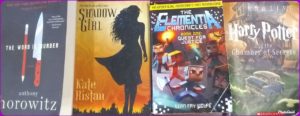Five Midnights by Ann Cardinal Davila
Tor Teen, 2019
ISBN-13: 978-1250296078
Available: Hardcover, paperback, Kindle edition, and audiobook
“When the U.S. gets a cold, Puerto Rico gets pneumonia.” In the United States, the mainland tends to forget that Puerto Rico is part of the country, and many Puerto Ricans have learned that federal government agencies don’t really want to get involved when disaster hits due to this (witness the travesty of the aftermath of Hurricane Maria). Five Midnights takes place before the hurricane hit, but it is easy to see that mainlanders, mostly white and wealthy, are viewed with suspicion due to their contribution to gentrification, which is driving locals out of even middle class neighborhoods to areas where gangs, drugs and crime are profitable and attractive tp teenagers trying to make it in a struggling economy. It’s no surprise when Vico, a successful teenage drug dealer, dies violently while on his way to a deal, but what only the reader knows is that the death is due to a shadowy, clawed, supernatural creature.
Enter Lupe, a half-Puerto Rican, half-white teenager who has traveled from Vermont to Puerto Rico to spend the summer with her aunt and uncle (who is also the chief of police). Lupe is independent and contrary, and fascinated by crime, an interest her uncle has previously encouraged. The case of the drug dealer touches on a family member, her cousin Izzy, who has disappeared, and her uncle does not want her involved, but that only makes Lupe more determined. Lupe is feminist in a very teenage girl “I can do it myself, don’t you dare help me” kind of way, an attitude that made an otherwise independent young woman seem like she needed to be rescued (for instance, walking into traffic because it was suggested she wait, and having to be pulled out of the street after nearly getting hit by a car). Her character does grow a lot as she meets a variety of people and experiences parts of Puerto Rico she wouldn’t have seen as a tourist and begins to understand the impact the mainland, and especially mainland investors, are having on the country. Cardinal does a great job in describing pre-Hurricane Maria Puerto Rico. I almost felt like I was there. I want to give her props, too, for her portrayal of adults in the story. YA fiction frequently depicts adults as clueless and closed-minded, but when these teens really needed them, the majority of adults listened, and stepped up, without taking over.
Because Lupe resembles her white mother instead of her Puerto Rican father, she also gets a lesson in colorism. Although she sees herself as Puerto Rican, the other teens she encounters call her “gringa”, white girl. It’s confusing to her at first, because she identifies as half-Puerto Rican, and can’t understand why no one else understands that. However, she comes to recognize that she does have white privilege and as a mainland American takes some things for granted that many Puerto Ricans cannot. At the same time, the friends she makes come to recognize that there are parts of her that are very Puerto Rican after all, even if they’re not immediately visible.
Our other major character is Javier, who grew up with Vico and Izzy, but kicked his drug habit and is working hard to stay clean and make up for the damage he did while he was involved with drugs. Despite a rocky beginning, Lupe and Javier decide to team up to find Izzy and solve Vico’s murder. They become more and more convinced that El Cuco, a shadowy supernatural creature bent on retribution is after Javier and his friends. It is refreshing to see a monster grounded in local folklore, appearing in a contemporary story, instead of the same tired tropes.
I loved seeing Puerto Rico take center stage when so often it’s ignored, and enjoyed watching Lupe and Javier puzzle out the mystery and each other. The climax is an outstanding, terrifying, mystical, and visually evocative piece of writing. This was Cardinal’s debut novel, and I look forward to her next one, Category Five, set in post-Hurricane Maria Puerto Rico. This is a truly Stoker-worthy book. Highly recommended.
Contains: violence, murder, mild gore, drug abuse
Editor’s note: Five Midnights was nominated to the final ballot of the 2019 Bram Stoker Award in the category of Superior Achievement in a Young Adult Novel.






Follow Us!